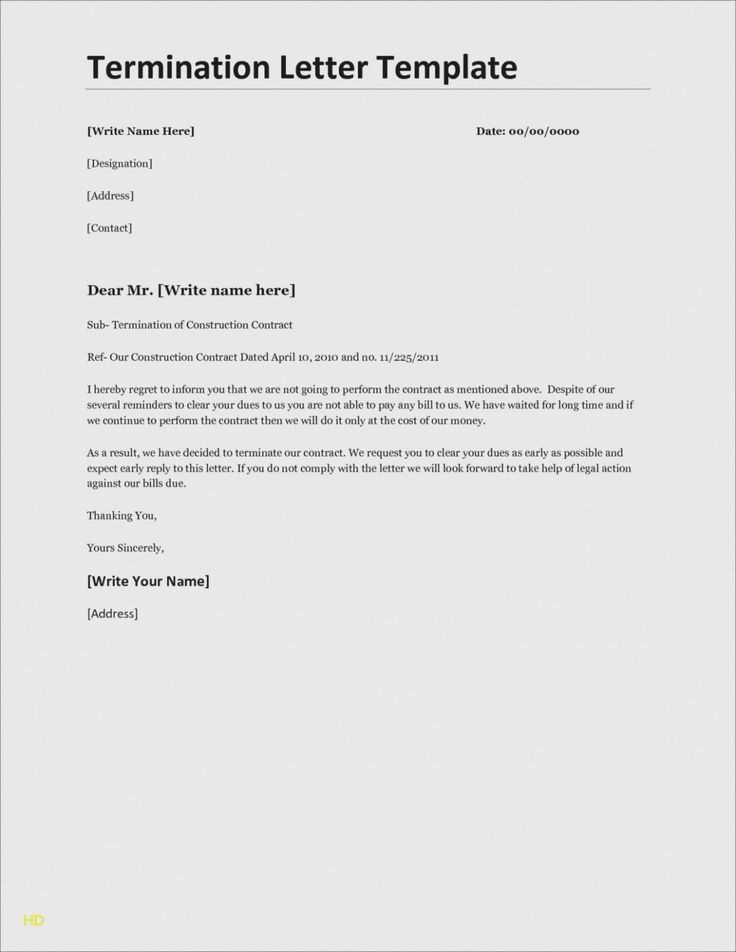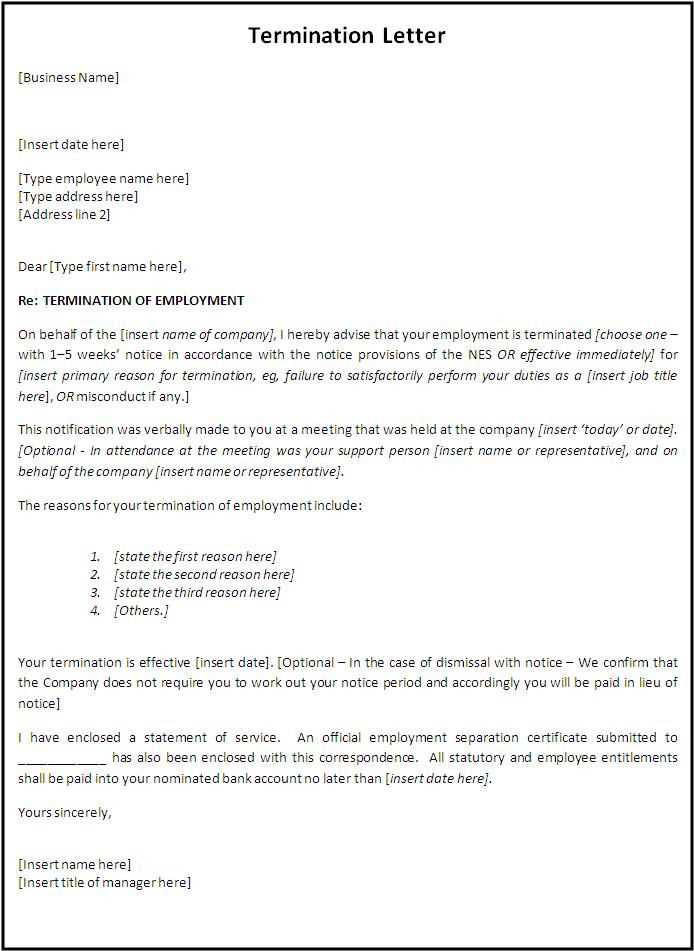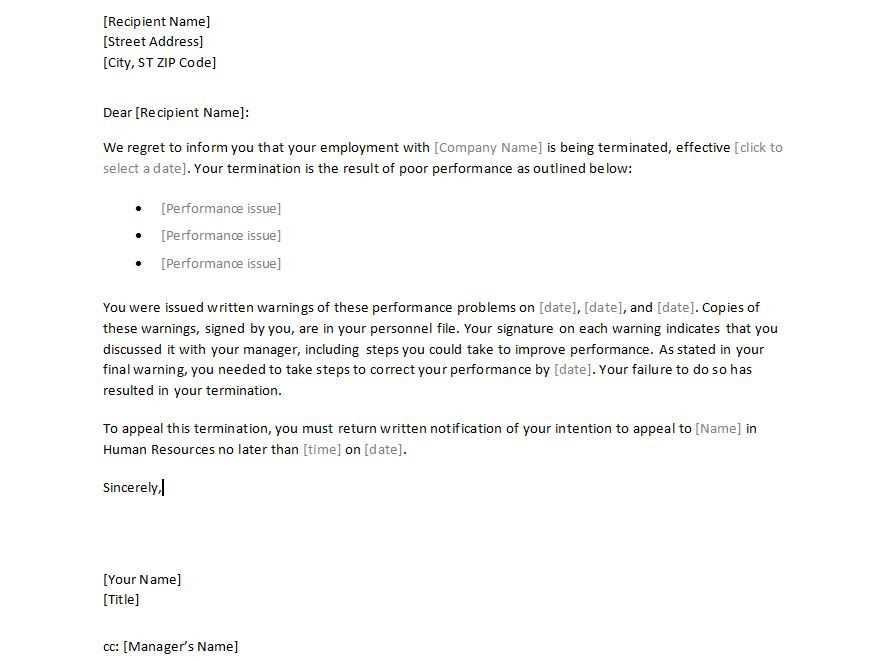Termination letter template for poor performance

Start by clearly outlining the reason for termination in a direct and professional manner. The employee should understand the specific performance issues that led to this decision. Avoid generalizations or vague language. Be specific about the tasks or goals that were not met.
Example: “This letter serves as formal notice of the termination of your employment due to continued underperformance. Despite multiple discussions about meeting sales targets and improving customer service ratings, there has been no significant improvement in these areas over the past six months.”
Next, reference any previous warnings or performance reviews to give context to the decision. Mention dates and any steps taken to support the employee in improving performance. This helps establish that the decision was made after careful consideration.
Example: “You were given a written warning on [date] regarding your failure to meet the required performance standards. In addition, we have had several meetings where we discussed action plans and provided additional training to help you improve in these areas.”
End the letter on a professional note, offering any necessary details on final payments, return of company property, or other logistical matters. Always ensure the language is respectful and empathetic, even if the situation is difficult.
Example: “Your final paycheck will include any unpaid wages and unused vacation time, and we will schedule a time for you to return any company property. We wish you the best in your future endeavors.”
Here are the revised lines:
Be clear and direct about the decision. Mention the key reason for termination, focusing on specific performance issues. Avoid generalizations; provide tangible examples of the poor performance, such as missed deadlines, failure to meet targets, or lack of improvement after feedback.
Example:

“After multiple discussions and a review of your performance, it has become clear that your work continues to fall short of expectations. Despite the feedback and support offered, there has been no significant improvement in meeting the required standards.”
Next Steps:

Provide information on any actions that need to be taken, like returning company property or completing necessary paperwork. Keep the tone respectful but firm.
“Please ensure that all company property is returned by [date]. You will also need to complete an exit interview with HR, who will guide you through the next steps.”
- Termination Letter Template for Underperformance
When addressing underperformance, it’s crucial to be clear, concise, and respectful. Below is a sample termination letter template that outlines how to communicate the decision professionally and fairly.
Termination Letter Template
Dear [Employee’s Name],
After careful review of your performance over the past [time period], we regret to inform you that your employment with [Company Name] will be terminated effective [termination date]. This decision follows multiple discussions regarding your performance and an attempt to provide the necessary support for improvement.
Despite several performance reviews and feedback sessions, we have not seen the expected improvements in your work. The areas where performance has not met the required standards include [list specific areas, such as missed deadlines, quality of work, teamwork, etc.]. We have provided [details of support offered, such as additional training, resources, or mentorship] in an effort to help you meet performance expectations, but these efforts have not yielded the desired results.
Your final paycheck, including any accrued vacation days, will be provided on your last working day. Please return any company property, including keys, equipment, and documents, by [date]. If you have any questions about your benefits or final paycheck, please contact [HR representative name] at [contact information].
We wish you the best in your future endeavors.
Sincerely,
[Your Name]
[Your Position]
[Company Name]
Key Points to Include in a Termination Letter

- State the termination date clearly.
- Detail the performance issues that led to the decision.
- Reference previous attempts to resolve the performance issues.
- Provide information about the final paycheck and any other benefits.
- Be professional and courteous throughout the letter.
Clearly state the reason for dismissal, focusing on specific instances of poor performance. Avoid generalizations; instead, refer to measurable outcomes such as missed targets, low productivity, or consistent mistakes. Include dates or periods when these issues occurred to provide context and transparency.
Be direct and objective. Use facts and avoid personal opinions or emotional language. For example, you might write, “Over the past six months, your sales performance consistently fell below the department’s target by 20%,” or “Despite multiple feedback sessions, there was no significant improvement in your project delivery times.”
Keep the tone professional. While it’s important to address the issue head-on, maintain a respectful tone to avoid unnecessary conflict. Acknowledge any positive contributions they made, if applicable, but balance this with the reasoning behind the decision.
Be clear about the consequences of ongoing performance issues. It’s helpful to reference any prior warnings or meetings that addressed performance. This reinforces that the decision wasn’t made hastily and was part of a process.
Begin with a clear heading that includes the date and the employee’s name. This sets the formal tone of the letter and provides immediate context.
The opening paragraph should directly state the purpose of the letter–informing the employee of their termination. Be straightforward without unnecessary details or ambiguity. Reference the employee’s role and the decision made based on performance issues.
Next, outline the performance concerns. Include specific examples of where performance did not meet expectations, highlighting any prior discussions or performance reviews that addressed these issues. This provides clarity and helps the employee understand the reasons for the decision.
In the following section, explain any support or resources that were provided to help improve performance, such as training or coaching. This section helps reinforce the fairness of the decision, showing that efforts were made to assist the employee.
Conclude with the necessary logistical details–final paycheck, return of company property, and any severance information. Ensure the tone remains respectful and professional. Offering assistance with the transition, such as providing a reference or outplacement services, can also be included here.
Lastly, close the letter with a polite, professional sign-off. This maintains a respectful tone, even in difficult situations, and leaves the door open for any future correspondence.
Clearly highlight instances of underperformance to provide clarity and a sense of fairness. Be specific with the examples and avoid generalizations. This ensures the recipient understands exactly where they fell short. For instance, instead of saying “missed deadlines,” specify “failed to meet the project deadline of January 15, which resulted in delays for the entire team.” Here are some ways to approach this:
- Failure to meet project milestones within the given time frame, such as the delay of the quarterly report by two weeks.
- Inconsistent quality of work, for example, submitting documents with multiple errors despite prior training on the company’s formatting standards.
- Lack of communication, such as not responding to emails or informing the team about delays, which impacted project coordination.
- Failure to meet performance targets, like not achieving the expected sales quota for three consecutive months despite clear targets being set.
- Not following instructions, such as missing key details in client proposals that led to dissatisfaction from clients.
Using concrete examples will help the individual understand exactly where improvements are needed and how their actions impact the team and business. Ensure these examples are factual and relevant to the specific performance expectations outlined in the role.
Ensure that all performance issues are documented thoroughly. Keep records of all performance reviews, feedback, and any previous warnings given to the employee. This documentation serves as proof in case of legal disputes.
Review the terms of the employee’s contract, focusing on any clauses related to termination and performance standards. This helps ensure compliance with agreed-upon policies and avoids potential legal challenges.
Verify compliance with labor laws that apply in your region, especially regarding wrongful termination claims. Different jurisdictions have specific requirements for dismissals, such as notice periods or the provision of severance pay.
Consult with a legal professional to ensure that the termination process adheres to relevant regulations. A lawyer can help confirm that all necessary steps are taken to minimize the risk of litigation.
Offer the employee a chance to respond to the performance issues, and keep a record of any conversations or meetings held to discuss their performance. This shows fairness in the process.
Use clear and concise language to communicate the decision. Focus on the facts and avoid personal judgments. Acknowledge the employee’s contributions in a neutral tone, showing appreciation for their efforts without compromising the main message. When detailing performance issues, be specific but tactful, providing concrete examples without sounding accusatory. Offer constructive feedback and potential next steps, ensuring the employee feels their concerns are heard. Stay calm and avoid emotional language, as this can escalate the situation unnecessarily. Lastly, ensure the letter remains courteous, offering the employee the opportunity to discuss the situation further if needed.
Ensure that the employee receives clear communication regarding the termination. Arrange for a formal meeting to discuss the content of the termination letter, providing an opportunity for the individual to ask questions and clarify any concerns.
Retrieve company property, including access cards, laptops, phones, and any other materials. Make a checklist to ensure nothing is missed during this process.
Confirm the final paycheck details, including unused leave or other benefits, and outline any severance packages, if applicable. Clarify the date and method of payment.
Instruct the employee on the process for returning any company-related data or confidential materials. Set a clear deadline for the return and provide necessary instructions to ensure a smooth transition.
Notify the relevant departments, such as HR, IT, and security, to disable access to systems, email accounts, or other resources that may pose a risk after the termination.
Provide the employee with the opportunity for an exit interview. Focus on gathering feedback that could help improve internal processes or identify areas of concern that might have led to the termination.
Document all actions and communications to ensure proper record-keeping and compliance with company policies and legal requirements.
Provide a clear and direct explanation of the reasons behind the termination. Reference specific performance issues, such as missed deadlines, failure to meet goals, or lack of improvement despite feedback. This helps ensure the employee understands the cause of the decision.
Use precise language to describe performance expectations that were not met. For instance, instead of vague statements, specify if the employee’s output consistently fell below expected standards or if their conduct was unprofessional. Be factual and avoid emotional language.
Include any steps taken to address the performance concerns, such as performance reviews, coaching sessions, or additional training. This shows that you provided opportunities for improvement before the termination decision was made.
Incorporate a table that outlines the specific performance metrics that were not achieved. This helps the employee see where they fell short and provides concrete evidence supporting the decision.
| Performance Metric | Expected Outcome | Actual Performance |
|---|---|---|
| Project Completion | Completed on time | Late by 2 weeks |
| Quality of Work | Meets company standards | Frequent errors, needed revisions |
| Team Collaboration | Actively participates in team meetings | Minimal contribution, lack of communication |
Conclude with a brief section on the next steps, including the final paycheck, return of company property, and any other necessary actions. This helps the employee know what to expect moving forward.